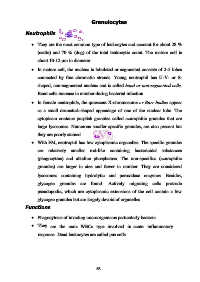Page 68 - Headlines Histology2024_Neat
P. 68
Granulocytes
Neutrophils
• They are the most common type of leukocytes and account for about 28 %
(cattle) and 70 % (dog) of the total leukocytic count. The mature cell is
about 10-12 ?m in diameter.
• In mature cell, the nucleus is lobulated or segmented consists of 2-5 lobes
connected by fine chromatin strands. Young neutrophil has U-V- or S-
shaped, non-segmented nucleus and is called band or non-segmented cells.
Band cells increase in number during bacterial infection.
• In female neutrophils, the quiescent X-chromosome or Barr bodies appear
as a small drumstick-shaped appendage of one of the nuclear lobe. The
cytoplasm contains purplish granules called azurophilic granules that are
large lysosomes. Numerous smaller specific granules, are also present but
they are poorly stained.
• With EM, neutrophil has few cytoplasmic organelles. The specific granules
are relatively smaller rod-like containing bactericidal substances
(phagocytins) and alkaline phosphatase. The non-specifics (azurophilic
granules) are larger in size and fewer in number. They are considered
lysosomes containing hydrolytic and peroxidase enzymes. Besides,
glycogen granules are found. Actively migrating cells protrude
pseudopodia, which are cytoplasmic extensions of the cell contain a few
glycogen granules but are largely devoid of organelles.
Functions
• Phagocytosis of invading microorganisms particularly bacteria.
• They are the main WBCs type involved in acute inflammatory
response. Dead leukocytes are called pus cells.
68

